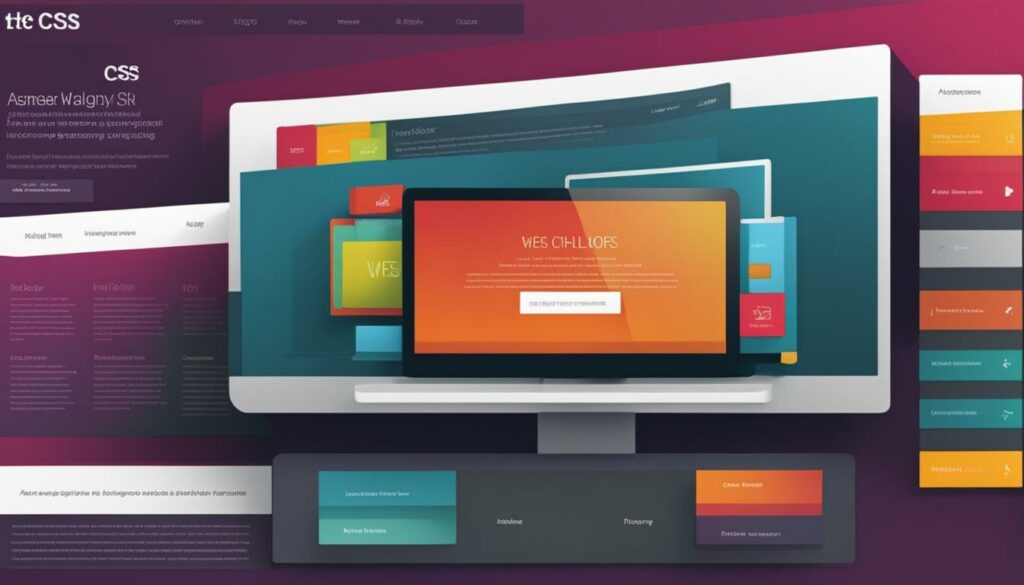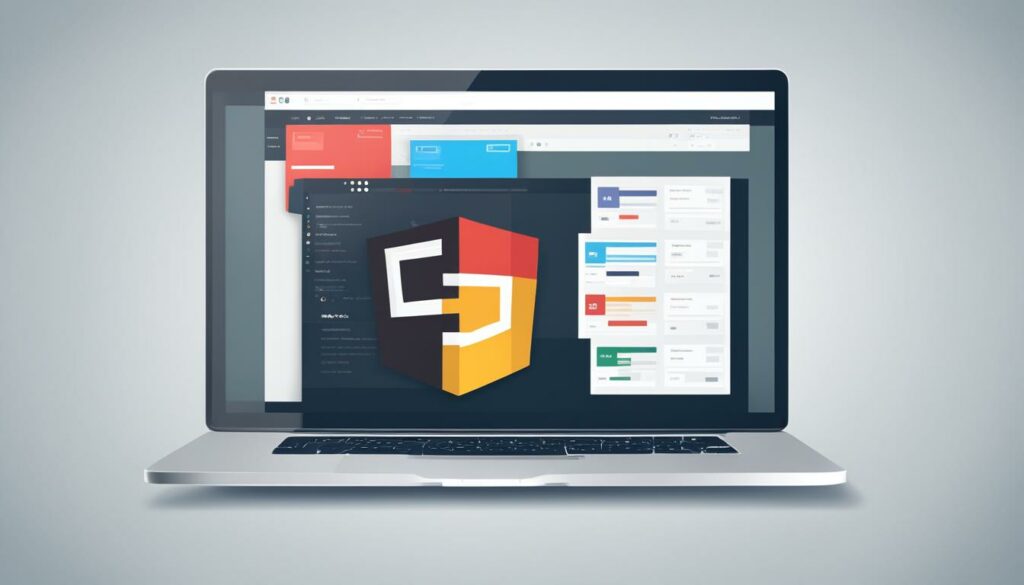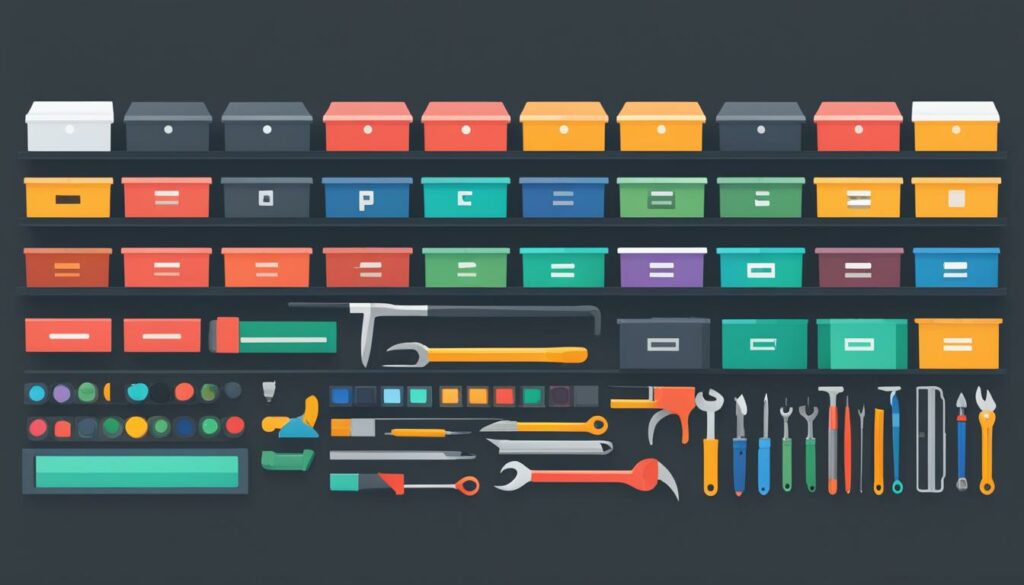Welcome to the world of web development! If you’re new to the field or looking to enhance your skills, it’s essential to understand Cascading Style Sheets (CSS). CSS is a stylesheet language that plays a vital role in styling and designing websites. It works hand in hand with HTML to define how elements should be presented on the web.
Imagine HTML as the structure of a building, and CSS as the paint, furniture, and decor that brings it to life. Without CSS, web pages would lack visual appeal and feel incomplete. CSS allows you to tailor the appearance of your web pages, incorporating colors, typography, layout, and more. It’s like having a magic wand to transform a plain webpage into a visually captivating masterpiece.
With CSS, you can create stunning and responsive designs, ensuring your website looks great on all devices. Whether you’re a front-end developer, a web designer, or someone interested in learning the art of web development, CSS is a skill you must possess!
So, get ready to explore the world of CSS and unlock your creativity in web design. In this article, we’ll delve into the basics of CSS, learn how to style text, understand CSS layout, solve common problems, discover its compatibility, and much more. By the end, you’ll be equipped with the knowledge and resources to become a CSS pro!
Key Takeaways:
- Cascading Style Sheets (CSS) is a stylesheet language used to describe the presentation of a web document written in HTML or XML.
- CSS is essential for web development, allowing developers to style and layout web pages and enhance the visual appearance of websites.
- CSS enables responsive design, ensuring that websites look great on various devices.
- Understanding CSS basics, styling text, layout techniques, and problem-solving strategies is essential for creating visually appealing web designs.
- Joining the CSS community and staying updated on CSS standardization are valuable ways to enhance your CSS skills.
The Basics of CSS
For beginners in web development, it is important to understand the basics of CSS. The CSS learning area offers a variety of tutorials that cover all the fundamentals of CSS. From learning how to write CSS code to understanding CSS properties and concepts, these resources will help you become proficient in using CSS.
If you are new to CSS and want to start learning, the CSS learning area is a great place to begin. It provides step-by-step tutorials that introduce you to the syntax and structure of CSS. You will learn how to select HTML elements, apply styles, and create layouts using CSS.
Once you have a solid understanding of CSS basics, you can explore more advanced topics and techniques. The CSS learning area offers tutorials on responsive design, CSS animations, and CSS frameworks, among others. These tutorials will help you enhance your CSS skills and stay updated with the latest trends and best practices in front-end web development.
Comprehensive CSS Reference
For seasoned web developers, a comprehensive CSS reference is available to provide detailed information about every property and concept in CSS. This reference serves as a valuable resource for quickly searching and understanding CSS syntax, selectors, properties, and values. Whether you need to refresh your memory or dive deep into specific CSS topics, the reference will help you find the information you need.
As a front-end web developer, having a solid understanding of CSS is essential. CSS allows you to style and layout web pages, create visually appealing designs, and ensure a consistent and engaging user experience. By mastering the basics of CSS and staying updated with new developments, you can become a skilled front-end web developer and create stunning websites that stand out from the crowd.
Boost your CSS skills and become a front-end web developer with the help of the CSS learning area, tutorials, and reference resources available. Sign up for courses and modules that suit your learning style and start your journey towards becoming a CSS expert.
Remember, practice makes perfect. The more you experiment with CSS and apply it to real-world projects, the better you will become. So don’t hesitate, dive into the world of CSS and unlock your potential as a front-end web developer!
Styling Text with CSS
One of the most exciting aspects of CSS is the ability to style text on your web page. With CSS, you can apply various properties to manipulate the appearance of text and make it visually appealing. Let’s explore some key techniques for styling text using CSS.
Font Styles
One of the fundamental features of CSS is the ability to define the font of your text. With CSS syntax, you can specify a specific font family, such as Arial or Times New Roman, to apply to your text. For example:
p {
font-family: Arial, sans-serif;
font-size: 16px;
}
The above CSS code sets the font family to Arial and the font size to 16 pixels for all paragraphs on your web page.
Text Decorations
Another way to style your text with CSS is by adding decorations, such as boldness or italics. You can achieve this by applying CSS properties like font-weight and font-style.
For example, to add boldness to a headline, you can use the following CSS code:
h1 {
font-weight: bold;
}
To emphasize a specific word or phrase, you can use italics:
em {
font-style: italic;
}
Line and Letter Spacing
With CSS, you can control the spacing between lines and letters, allowing you to refine the visual presentation of your text. Adjusting the line height property affects the space between lines, while the letter spacing property modifies the spacing between individual characters.
For example, to increase line spacing, you can use the following CSS code:
p {
line-height: 1.5;
}
To add more space between letters, you can use the letter-spacing property:
p {
letter-spacing: 1px;
}
Drop Shadows
Drop shadows can add depth and visual interest to your text. CSS allows you to apply drop shadows to text elements using the text-shadow property.
For example, to create a drop shadow effect on a heading, you can use the following CSS code:
h1 {
text-shadow: 2px 2px 4px rgba(0, 0, 0, 0.5);
}
Custom Fonts
With CSS, you can also use custom fonts to style your text and make it unique. By linking to external font files or utilizing web font services, you can apply a wide range of custom fonts to your web page.
For example, to use a custom font called “Open Sans” for your paragraphs, you can use the following CSS code:
p {
font-family: 'Open Sans', sans-serif;
}
Lists and Links
In addition to styling regular text, CSS can also be used to style lists and links. Lists can be customized by adjusting properties such as list-style-type and list-style-image. Links can be styled using properties like color, text-decoration, and hover effects.
For example, to create a list with square bullets, you can use the following CSS code:
ul {
list-style-type: square;
}
To style links with an underline and change the color on hover, you can use the following CSS code:
a {
text-decoration: underline;
color: blue;
}
a:hover {
color: red;
}
By utilizing these CSS techniques, you can have full control over the visual presentation of your text, making it more engaging and impactful for your website visitors. Remember to experiment with different properties and styles to create a truly unique and visually appealing design!
Boost Your CSS Skills with WordPress Hosting from BoostedHost

To take your CSS skills to the next level and create stunning web designs, we recommend using WordPress Hosting from BoostedHost. With BoostedHost, you can enjoy optimal performance and reliability, ensuring that your CSS styles are rendered seamlessly on your website. Sign up now through this link: www.boostedhost.com/wordpress-hosting.
CSS Layout
CSS layout is a crucial aspect of web development that involves positioning and arranging elements on a web page. By understanding CSS layout techniques and concepts, you can create visually appealing and well-structured web designs.
One important concept in CSS layout is the viewport. The viewport determines how elements are placed in relation to the visible area of the browser window. It allows you to create responsive designs that adapt to different screen sizes, providing a seamless browsing experience for your users.
CSS provides various display settings that allow you to control the layout of elements. Two popular options are flexbox and CSS grid. Flexbox is a powerful CSS layout model that enables you to create flexible and dynamic layouts, while CSS grid provides a two-dimensional grid system for creating complex and responsive layouts.
Another essential aspect of CSS layout is positioning. CSS offers different positioning options such as static, relative, absolute, and fixed. By using these positioning techniques, you can precisely control the placement of elements on your web page.
It’s important to note that while modern CSS layout techniques like flexbox and CSS grid are widely supported by modern browsers, it’s also crucial to understand legacy techniques for compatibility with older browsers. Legacy techniques include using floats and clearfix to create multi-column layouts.
By mastering CSS layout, you can create visually appealing and responsive web pages that enhance the user experience. Whether you’re creating a simple personal blog or a complex e-commerce website, CSS layout is a fundamental skill for every web developer.
Take a look at the CSS Layout cheat sheet below for a summary of CSS layout concepts:
| Concept | Description |
|---|---|
| Viewport | The visible area of the browser window. |
| Display settings | Options like flexbox and CSS grid for creating layouts. |
| Positioning | Techniques for precisely controlling element placement. |
| Legacy techniques | Older techniques for compatibility with older browsers. |

Understanding and implementing CSS layout is essential for creating visually appealing and well-structured web pages. Whether you’re using flexbox, CSS grid, or legacy techniques, mastering CSS layout will empower you to create engaging and responsive web designs.
Using CSS to Solve Common Problems
CSS is a powerful tool for web page creation that allows you to style and design your website to perfection. However, as with any technology, you may encounter certain challenges along the way. The good news is that CSS provides solutions for solving common problems that arise during the development process.
Aligning Elements
One of the most common CSS problems is aligning elements on a web page. Whether you want to center a div, adjust the spacing between elements, or create a specific layout, CSS offers a range of techniques to help you achieve your desired alignment. By using CSS properties such as text-align, margin, and padding, you can easily position elements exactly where you want them.
Creating Responsive Designs
In today’s digital landscape, it’s crucial to create websites that are responsive and adapt to different screen sizes. CSS makes it possible to build responsive designs by using media queries, flexbox, and CSS grid. These CSS features allow you to create layouts that adjust and reflow based on the device or screen size, providing an optimal user experience on desktops, tablets, and mobile devices.
Troubleshooting Layout Issues
Layout issues can be frustrating when developing a web page. Luckily, CSS offers a range of debugging techniques to help you identify and fix layout problems. One valuable resource is the Firefox Developer Tools, a set of built-in tools available in the Firefox web browser. With these tools, you can inspect and modify your CSS code in real-time, making it easier to debug and troubleshoot any layout issues you may encounter.
CSS Validation
Validating your CSS code is crucial for ensuring that your web page is correctly interpreted and displayed by different browsers. The W3C CSS Validation Service is a valuable tool that helps you identify and fix any syntax errors or compatibility issues in your CSS code. By validating your CSS, you can ensure that your web page meets industry standards and functions consistently across various platforms.
By utilizing CSS problem-solving techniques, web developers can overcome challenges and create visually stunning and functional web pages. Whether it’s aligning elements, creating responsive designs, or debugging layout issues, CSS provides the tools and resources needed to achieve the desired results in web design.
CSS and Web Languages
CSS, the fundamental styling language of the web, can be applied to various web languages such as HTML, SVG, MathML, XHTML, and XML. These languages serve as the foundation for creating web content, while CSS enhances their visual presentation, improving the overall user experience. Understanding how CSS interacts with these web languages is essential for effective and seamless web design.
“The combination of CSS and web languages like HTML and SVG allows developers to create stunning and dynamic websites. CSS provides the tools to style and format web elements, making them visually appealing and well-structured. By using CSS in conjunction with HTML and other web languages, web developers have the power to create engaging and interactive web experiences.”
HTML, the backbone of web content, is responsible for structuring and organizing the elements of a webpage. By utilizing CSS selectors and properties, developers can modify the appearance and layout of HTML elements, bringing life to their designs.
SVG, Scalable Vector Graphics, is a web language used for creating vector graphics with XML. CSS can be applied to SVG elements, allowing developers to style and animate vector graphics, creating visually striking images and illustrations.
MathML, a markup language for mathematical notation, enables the display of complex mathematical equations on the web. CSS can be used to style MathML elements, enhancing the readability and visual coherence of mathematical content.
XHTML, a stricter version of HTML, combines the benefits of XML with the familiar structure of HTML. With CSS, developers can efficiently style XHTML documents, ensuring consistency and visual appeal across various web browsers.
XML, the extensible markup language, is a versatile data format used for storing and transporting structured data. CSS can be applied to XML documents to present the data in a visually appealing way, improving readability and comprehension.
By leveraging the power of CSS in conjunction with these web languages, developers can create captivating and user-friendly web experiences that showcase their creativity and expertise.

| Web Language | Application of CSS |
|---|---|
| HTML | Apply CSS properties to style and format HTML elements for visually appealing web pages. |
| SVG | Use CSS to style and animate vector graphics, creating visually striking images and illustrations. |
| MathML | Apply CSS to enhance the readability and visual coherence of mathematical content on the web. |
| XHTML | Efficiently style XHTML documents using CSS, ensuring consistency and visual appeal across web browsers. |
| XML | Utilize CSS to present structured data in XML documents in a visually appealing and easy-to-read manner. |
CSS Resources and Tools
When working with CSS, having access to the right resources and tools can greatly enhance your development workflow. Whether you’re a beginner or an experienced developer, these CSS resources can help streamline your coding process and create stunning web designs.
CSS Software and Applications
CSS software and applications provide a user-friendly interface for writing and managing CSS code. Some popular options include:
- Adobe Dreamweaver
- Visual Studio Code
- Sublime Text
- Atom
These tools often come with features like code auto-completion, syntax highlighting, and integration with version control systems, making it easier to write and debug CSS code. Choose the one that best suits your preferences and coding style.
External Stylesheets
External stylesheets allow you to separate your CSS code from your HTML files, promoting better organization and easier maintenance. By linking your HTML files to an external CSS file, you can apply consistent styles across multiple web pages. This saves time and effort by eliminating the need to duplicate CSS code in every HTML file.
To link your HTML file to an external CSS file, use the <link> tag and specify the path to your CSS file. For example:
<link rel=”stylesheet” href=”styles.css”>
CSS Bugs and Workarounds
While CSS is a powerful tool, it is not without its quirks and bugs. Different web browsers may interpret CSS code differently, resulting in inconsistencies and layout issues. It’s essential to be aware of common CSS bugs and their workarounds to ensure your designs look consistent across browsers.
Online resources and developer forums, such as the CSS-Tricks website and Stack Overflow, can provide valuable insights and solutions to commonly encountered CSS problems.
CSS Demos and Inspiration
To stay up-to-date with the latest CSS technologies and trends, CSS demos offer an excellent source of inspiration. These demos showcase the capabilities of CSS through interactive examples and visual effects.
Browsing through CSS demo websites, such as CodePen or CSS Zen Garden, can spark your creativity and demonstrate the innovative potential of CSS in web design.
CSS Reference and Documentation
Having reliable CSS reference material is crucial for both beginners and seasoned developers. CSS reference websites provide comprehensive documentation and examples of CSS properties, selectors, and concepts.
Sites like the Mozilla Developer Network (MDN) and the W3Schools CSS Reference offer detailed explanations and practical code examples to help you better understand CSS and its various features.
CSS Layout Cookbook
Implementing specific designs and layouts can sometimes be challenging, especially for complex web pages. The CSS layout cookbook provides a collection of recipes and examples for common layout patterns, guiding developers in achieving their desired designs.
These recipes cover various CSS techniques, such as flexbox, float-based layouts, and CSS grid, allowing you to experiment with different options and choose the best approach for your project.

| Resource/Tool | Description |
|---|---|
| Adobe Dreamweaver | A professional software for web design and development, with CSS code editing capabilities. |
| Visual Studio Code | A popular code editor with built-in support for CSS, offering features such as auto-completion and debugging. |
| Sublime Text | A lightweight code editor known for its speed and extensibility, widely used among web developers. |
| Atom | An open-source code editor built by GitHub, highly customizable and suitable for front-end development. |
| CSS-Tricks | An online resource with tutorials, articles, and forums covering a wide range of CSS topics. |
| Stack Overflow | A question-and-answer website where developers can ask for help and find solutions to CSS and other coding issues. |
| CodePen | An online community for sharing and showcasing HTML, CSS, and JavaScript code snippets. |
| CSS Zen Garden | A website featuring a collection of CSS designs applied to a single HTML file, demonstrating the creative possibilities of CSS. |
| Mozilla Developer Network (MDN) | An extensive web development resource with detailed documentation and examples of CSS and other web technologies. |
| W3Schools CSS Reference | A comprehensive reference guide with explanations and examples for CSS properties and concepts. |
CSS Standardization and Versions
In the world of web development, CSS plays a vital role in styling and presenting web pages. To ensure consistency and interoperability across different browsers and platforms, CSS is standardized according to W3C specifications. This standardization process ensures that CSS is reliable and can be used effectively by developers worldwide.
In the past, CSS had version numbers like CSS1, CSS2.1, and CSS3. However, the approach has evolved over time. Instead of having specific versions like CSS3 or CSS4, the current approach involves taking periodic snapshots of the latest stable state of the CSS specification and individual modules. This approach allows for a more flexible and modularized development process.
CSS modules are designed to enhance specific areas of CSS functionality, such as layout, typography, or animations. Each CSS module has its own version number or level, indicating its progress and stability. This modular approach enables developers to have granular control over the CSS features they use, making it easier to create sophisticated and responsive web designs.
By adhering to CSS standardization and keeping up with the latest versions and module updates, developers can ensure that their CSS code is compatible with different browsers and platforms. This compatibility is crucial for delivering consistent and visually appealing web experiences to users.
To summarize, CSS standardization ensures that CSS is reliable and follows consistent rules across different platforms. While specific version numbers like CSS3 or CSS4 are no longer used, CSS modules provide detailed updates and improvements to specific areas of CSS functionality. By staying informed and incorporating the latest standards and modules into their work, developers can create cutting-edge web designs that are compatible with a wide range of browsers and platforms.
CSS Standardization Snapshot:
| Module | Version/Level | Description |
|---|---|---|
| CSS Color Module Level 3 | Level 3 | Adds support for specifying and adjusting colors in CSS. |
| CSS Grid Layout Module Level 1 | Level 1 | Introduces a two-dimensional grid-based layout system in CSS. |
| CSS Flexible Box Layout Module Level 1 | Level 1 | Defines a layout system based on flexible boxes in CSS. |
| CSS Transitions Module Level 3 | Level 3 | Enables smooth transitions between different CSS property values. |
| CSS Animations Module Level 3 | Level 3 | Allows the creation of dynamic animations using CSS properties. |
Learning CSS: Courses and Resources
If you are new to CSS or looking to improve your skills, there are numerous resources available to help you get started. Whether you prefer interactive tutorials, comprehensive courses, or in-depth learning areas, you can find the right resources to enhance your CSS knowledge and proficiency. From the basics of CSS syntax and properties to advanced techniques, these resources cover a wide range of topics.
Online Tutorials
Online tutorials provide step-by-step guidance on CSS basics, allowing you to learn at your own pace. These tutorials often include code examples and interactive exercises to reinforce your understanding. Some popular CSS tutorial websites include:
- W3Schools CSS Tutorial
- MDN Web Docs CSS Learning Area
- Codecademy CSS Course
Comprehensive Courses
If you prefer a more structured learning approach, comprehensive CSS courses are available online. These courses cover CSS fundamentals, advanced techniques, and real-world applications. Some popular CSS courses include:
- CSS – The Complete Guide (incl. Flexbox, Grid & Sass) on Udemy
- Introduction to HTML and CSS on Udacity
- Web Design for Everybody: Basics of Web Development & Coding Specialization on Coursera
Learning Areas
Comprehensive learning areas provide a collection of resources, tutorials, and guides to help you explore CSS in-depth. These learning areas cover CSS basics, advanced techniques, and best practices. Some recommended CSS learning areas include:
- CSS-Tricks
- Codrops CSS Reference
- CSS Layout
Remember, the key to mastering CSS is practice and hands-on experience. Experiment with different CSS properties, create your own projects, and seek feedback from the CSS community. With dedication and the right resources, you can develop strong CSS skills and create visually stunning web designs.
| Resource | Description |
|---|---|
| W3Schools CSS Tutorial | A comprehensive online tutorial that covers CSS basics and advanced topics with code examples and interactive exercises. |
| MDN Web Docs CSS Learning Area | A learning area dedicated to CSS on MDN Web Docs, providing detailed guides and resources for beginners and advanced learners. |
| Codecademy CSS Course | An interactive CSS course on Codecademy that teaches the fundamentals of CSS through hands-on projects. |
| CSS – The Complete Guide (incl. Flexbox, Grid & Sass) on Udemy | A comprehensive CSS course on Udemy that covers CSS fundamentals, advanced techniques, and modern layout methods. |
| Introduction to HTML and CSS on Udacity | A beginner-friendly course on Udacity that teaches the basics of HTML and CSS for web development. |
| Web Design for Everybody: Basics of Web Development & Coding Specialization on Coursera | A specialization on Coursera that covers the basics of web development, including HTML, CSS, and responsive design. |
| CSS-Tricks | A popular CSS website that provides tutorials, articles, and resources for all levels of CSS learners. |
| Codrops CSS Reference | A comprehensive CSS reference guide with code examples and detailed explanations of CSS properties and concepts. |
| CSS Layout | A curated collection of CSS layout examples and patterns to help you design modern and responsive web layouts. |
CSS Support and Compatibility
CSS is an essential component of modern web development, allowing you to style and enhance your web pages. It is supported by most modern web browsers, ensuring that your CSS styles are rendered consistently across different platforms. This means that your web design will look great whether it’s viewed on a desktop computer, a tablet, or a mobile device.
However, it’s important to note that there may be compatibility issues with older browsers or specific CSS features. Some older browsers may not fully support the latest CSS specifications, which could result in the improper rendering of certain styles and layouts.
To overcome these compatibility issues, CSS prefixes and vendor-specific properties can be used. CSS prefixes are special codes added to CSS properties that target specific browser implementations or versions. By using CSS prefixes, you can ensure that your styles are correctly interpreted by different browsers. Here’s an example:
-webkit-border-radius: 5px;
-moz-border-radius: 5px;
border-radius: 5px;
In this example, -webkit- and -moz- are CSS prefixes that target specific browsers (Google Chrome and Mozilla Firefox) to apply the border radius property. The standard border-radius property is also included as a fallback for other browsers.
In addition to CSS prefixes, vendor-specific properties can also be used to target specific browsers. These properties are similar to CSS prefixes but are specific to a particular browser, such as -webkit-border-radius for Google Chrome. Here’s an example:
-webkit-border-radius: 5px;
border-radius: 5px;
Again, the -webkit- prefix targets Google Chrome, while the standard border-radius property serves as a fallback for other browsers.
In cases where certain CSS features are not supported by certain environments, polyfills can be used to provide fallback functionality. Polyfills are scripts that enable the use of modern CSS features in older browsers that do not natively support them. By including a polyfill in your code, you can ensure that your CSS styles and effects are displayed correctly across all browsers.
Overall, understanding CSS support and compatibility is crucial for delivering consistent web experiences to users. By using CSS prefixes, vendor-specific properties, and polyfills, you can overcome compatibility challenges and ensure that your web design is visually appealing and functional across different browsers and platforms.
Summary of CSS Support and Compatibility
In summary, CSS enjoys broad support from modern web browsers, allowing you to create visually stunning web designs. However, compatibility issues can arise with older browsers or specific features. To address these issues:
- Use CSS prefixes and vendor-specific properties to target specific browser implementations or versions.
- Consider using polyfills to provide fallback functionality for unsupported CSS features.
By applying these techniques, you can ensure that your CSS styles are rendered consistently across different platforms and browsers, providing a seamless user experience for your website visitors.
Joining the CSS Community
Being a part of the CSS community can greatly benefit your web development journey. Not only will you stay up-to-date with the latest developments and trends in CSS, but you’ll also have the opportunity to connect with fellow developers and learn from their experiences. Joining CSS discussions and becoming a member of the CSS working group mailing list allows you to contribute to the evolution of CSS and shape its future.
Engaging with the CSS community fosters collaboration and knowledge-sharing among web developers. Through discussions, you can exchange ideas, seek solutions to challenges, and gain insights into best practices. By actively participating in the CSS community, you’ll have the chance to learn from industry experts, receive valuable feedback on your work, and grow as a developer.
As you become more involved in the CSS community, you’ll discover a wealth of resources and networking opportunities. Online forums and communities dedicated to CSS offer a space for open discussions, Q&A sessions, and sharing of resources that can help you expand your knowledge and skillset. You may also come across CSS meetups and conferences where you can meet like-minded individuals, attend workshops, and listen to talks by renowned CSS experts.
Join the CSS community today and connect with developers from around the world who share your passion for CSS. Get involved in CSS discussions, join the CSS working group mailing list, and take advantage of the collaborative spirit that drives the CSS community forward.
H3: Benefits of Joining the CSS Community
- Become part of a supportive and knowledgeable community
- Stay updated with the latest trends and developments in CSS
- Learn from experienced professionals and industry experts
- Collaborate on projects and exchange ideas
- Receive valuable feedback and improve your skills
- Discover new resources, tools, and techniques
- Network with fellow developers and establish connections
Joining the CSS community is an excellent way to enhance your web development journey. By immersing yourself in discussions, contributing to the CSS working group mailing list, and engaging with fellow developers, you’ll be positioned to grow both personally and professionally.
Conclusion
In conclusion, Cascading Style Sheets (CSS) are an essential component of web development, enabling developers to style and layout web pages. From learning the basics of CSS syntax and properties to implementing advanced techniques like responsive design and CSS layout, mastering CSS is crucial for creating visually appealing and responsive websites.
By leveraging the vast array of resources and tools available, staying updated on CSS standardization, and actively participating in the CSS community, web developers can enhance their CSS skills and deliver exceptional web experiences. It is important to continuously explore and experiment with the latest CSS features and techniques to stay ahead in the dynamic world of web design.
Remember, CSS is not just about making a web page look good, but also about optimizing its performance and user experience. With the growing demand for responsive and interactive web designs, CSS has become even more indispensable in the field of web development. So, keep honing your CSS skills and exploring new possibilities to leave a lasting impact on the digital landscape.
We recommend BoostedHost’s WordPress Hosting for optimal performance and seamless integration of CSS into your WordPress website. Sign up now through this link and take your web development skills to the next level!
FAQ
Q: What is CSS?
A: CSS, or Cascading Style Sheets, is a stylesheet language used to describe the presentation of a document written in HTML or XML. It defines how elements should be rendered on different media such as screens, paper, or speech. CSS is a core language of the open web and is standardized across web browsers according to W3C specifications.
Q: What are the basics of CSS?
A: The basics of CSS include understanding CSS syntax, properties, and concepts. You can learn how to write CSS code and gain proficiency in using CSS through online tutorials, courses, and comprehensive learning areas. Seasoned web developers can also refer to a CSS reference that provides detailed information about every property and concept in CSS.
Q: How can I style text with CSS?
A: CSS allows you to style text by setting properties such as font, boldness, italics, line spacing, letter spacing, and drop shadows. You can also apply custom fonts to your web page and style lists and links using CSS. Understanding how to manipulate text using CSS is essential for creating visually appealing web designs.
Q: What is CSS layout?
A: CSS layout involves positioning and arranging elements on a web page. It includes concepts such as the viewport, which determines how elements are placed in relation to the visible area of the browser window. CSS provides various display settings, such as flexbox and CSS grid, which allow for more advanced and responsive layouts. Positioning is another important aspect of CSS layout, allowing developers to precisely control the placement of elements.
Q: How can CSS solve common problems in web development?
A: CSS can be used to solve common problems that arise when creating a web page. It helps in aligning elements, creating responsive designs, and troubleshooting layout issues. Tools such as the W3C CSS Validation Service and Firefox Developer Tools can assist in validating and debugging CSS code, ensuring that it is valid and achieves the desired results in web design.
Q: How does CSS interact with web languages?
A: CSS is often applied to various web languages such as HTML, SVG, MathML, XHTML, and XML. These languages serve as the foundation for creating web content, and CSS enhances their visual presentation. Understanding how CSS interacts with these web languages is essential for effective and seamless web design.
Q: What are some CSS resources and tools available?
A: There are numerous resources and tools available for working with CSS. Software applications simplify the process of writing CSS code, external stylesheets allow for easy and consistent styling across multiple web pages, and CSS bugs and workarounds help ensure the smooth functioning of CSS in different browsers. CSS demos provide examples of the latest CSS technologies in action, and the CSS layout cookbook offers recipes for common layout patterns.
Q: How does CSS standardization work?
A: CSS is standardized according to W3C specifications. The development and release of CSS specifications have evolved over the years, with different modules progressing at different rates. CSS modules have their own version numbers or levels, indicating their progress and stability.
Q: Where can I find resources to learn CSS?
A: If you are new to CSS or looking to improve your skills, there are various online tutorials, courses, and learning resources available. These resources cover CSS basics, syntax, properties, and advanced techniques, catering to different learning preferences and skill levels.
Q: How is CSS supported across different web browsers?
A: CSS is supported by most modern web browsers, ensuring that CSS styles are rendered consistently across different platforms. However, there may be compatibility issues with older browsers or specific features. CSS prefixes and vendor-specific properties can be used to target specific browser implementations or versions, and polyfills can provide fallback functionality for CSS features that are not supported in certain environments.
Q: What are the benefits of joining the CSS community?
A: Being a part of the CSS community allows you to stay up-to-date with the latest developments and trends in CSS. Joining CSS discussions and the CSS working group mailing list enables you to contribute to the evolution of CSS and learn from others in the field. Engaging with the CSS community fosters collaboration and knowledge-sharing among web developers.












